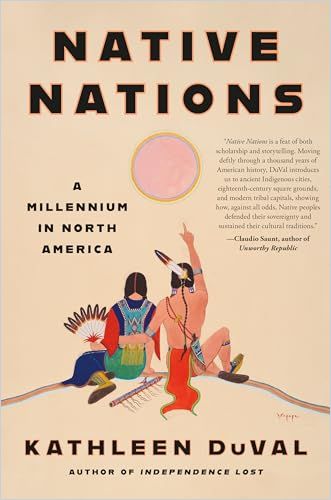Kathleen DuVal, recipient of the 2025 Pulitzer Prize for History, details Indigenous North Americans’ resilience, strength, pride, and cultural and political sophistication.

The Nations Endure
University of North Carolina history professor Kathleen DuVal, recipient of the 2025 Pulitzer Prize for History, asserts that United States history must centralize Native Americans’ perspectives and contributions – including their 20th- and 21st-century renaissance and revitalized languages, cultures, and political power.
Complex Societies
Long before European contact, Indigenous civilizations established economies, networks of diplomacy, and political structures. By the time of “discovery,” they had built cities and employed technologies that rivaled Europe’s. After the advent of Europeans, Native Americans constrained colonial expansion for centuries. Indigenous demands for rights and sovereignty enabled North America’s Native nations to thrive.
We’re a nation, and we expect to be treated like a nation.Katherine DuVal
DuVal shows how colonialism brought genocide and the steadily encroaching theft of land and resources. In the 1800s, white supremacist theories dismissed Native American accomplishments despite evidence of sophisticated precolonial civilizations, cities, trade systems, and agriculture.
In the late 1700s, English colonialists made contact with the Algonquin people of Ossomocomuck, on the Outer Banks of today’s North Carolina. Initially, both groups sought commerce and partnerships. Algonquian leaders valued European metal tools and weaponry; the English sought a foothold to disrupt Spanish control. However, the failure of the English colony in Roanoke exemplified the instability of colonial ambitions. The English “doctrine of discovery” claimed territories that Christians did not occupy. In a pattern repeated frequently nationwide, tensions arose between Indigenous people and settlers over land ownership, property rights, and reasons for military action.
The Iroquois Confederacy — made up of the Mohawk, Oneida, Onondaga, Cayuga, and Seneca nations, and later the Tuscarora – and its commerce, alliances, and military engagements influenced both other Indigenous nations and European settlers.
The presence of Europeans changed eastern North America, but mostly through Native decisions and actions.
The Mohawk formed partnerships with the Dutch to secure firearms and trade goods, while controlling trade routes, commerce, and the fur trade. However, people in the Iroquois Confederacy suffered from European diseases, prolonged conflicts, and internal divisions. European goods and the fur trade transformed the Confederacy’s economy and societal structures, though Indigenous women continued to play vital roles in farming, trade, and governance.
Native Resistance
In the 17th and 18th centuries, the Quapaw Nation defended its strategic location at the junction of the Mississippi and Arkansas rivers. The Quapaw set trade conditions with the colonists, who were reliant on their cooperation. To gain firearms, it welcomed French explorers in 1673.
Quapaw support for the French during the Natchez War secured trade goods, as the French remained economically and politically dependent on the tribe. As DuVal demonstrates, Quapaw diplomacy and control of crucial river routes shaped the power dynamics of the Mississippi Valley for a century.
Some Native communities stayed on their ancestral lands, which became the basis for reservations, which were diminished but protected land on which they maintained communal ownership while surrounded by white-owned farms. Eastern US authorities classified Native communities as “free people of color” to obscure their tribal identities and history.
People in the United States self-servingly imagined Native Americans as primitive nomads, supposedly wasting land that white Americans could farm.Kathleen DuVal
In the 18th century, the Shawnee, despite frequent relocation in response to conflict, upheld their traditions and identity by prioritizing community, diplomacy, and strategic alliances. As tensions escalated before the American Revolution, the Shawnee, determined to maintain their land, autonomy, and way of life, faced increasing struggles over territory and sovereignty.
Shawnee leaders Tenskwatawa and Tecumseh urged Indigenous peoples to set aside their tribal distinctions, reclaim ancestral lands, and revive traditional life. Native communities debated whether to adopt a broader Indigenous identity, migrate west, or safeguard their oppressed sovereignty in their homelands.
In the 19th century, rather than accepting assimilation or forced removal, the Cherokee Nation centralized its government and established a republican-style system with legislative, executive, and judicial branches. In 1827, the Cherokee adopted a written constitution, defined their territorial borders, and prohibited land sales to non-Cherokees. As government pressure persisted, they established a governing National Council to prevent unauthorized land cessions. The Cherokee also incorporated farming, trade, and plantation agriculture – including slave ownership – into their lives while resisting displacement.
Forced Removal and Assimilation
President Andrew Jackson called for the forced removal of Native Americans to advance so-called civilization. Native nations resisted with legal battles, treaty negotiations, and strategic alliances.
The Cherokee continued to advocate for their sovereignty in Congress, the courts, and newspapers. The Supreme Court’s Worcester v. Georgia ruling affirmed Cherokee sovereignty, but – with Jackson’s support – the state of Georgia ignored the decision, escalating conflicts and injustices.The Indian Removal Act resulted in the Trail of Tears, a forced westward march that killed thousands of people from the Cherokee Nation.
The Federal government outlawed Native American self-governance, sent Native children to distant Christian boarding schools, and banned Indigenous languages and religious ceremonies. Still, Native nations – including the Kiowas, Cherokees, and Mohawks – upheld their cultures.
Against the odds, Native America is experiencing a renaissance today as more young people are learning the languages, arts and crafts, and ceremonies of their ancestors and publicly asserting their tribal identities.Kathleen DuVal
The American government sought to dismantle Indigenous peoples’ communal identities and force them into non-Indigenous society. Against great adversity, Native communities preserved their traditions, revitalized their languages, and reinforced their collective identity. They asserted their rights and mustered new economic and cultural initiatives, leading to today’s resurgence of Native pride and self-determination.
Knowledgeable History
Kathleen DuVal challenges the common narrative of inevitable Native decline at the hands of European colonialism and diseases. She explores precolonial Indigenous urban centers and agricultural practices, as well as Native peoples’ agency, adaptations, and centuries of dominance over most of America. DuVal presents a nuanced understanding of Native American history while recognizing the enduring strength and adaptability of Indigenous cultures. Those fascinated by DuVal’s extraordinary prose, bottomless research, shattering of clichés, and singular knowledge will also enjoy her other books: Independence Lost: Lives on the Edge of the American Revolution; The Native Ground: Indians and Colonists in the Heart of the Continent; and Interpreting a Continent: Voices from Colonial America.












